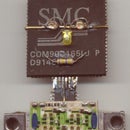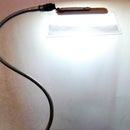Introduction: Stereo Amplifier, Dead Bug Style
I used the Texas Instruments TPS1517 stereo audio amplifier chip to build an amplifier to drive my speakers.
I found a pair of small 8 ohm, 0.5 watt speakers matching the color of my monitor and attached them with hot glue to its sides. They did not have amplifiers inside, and connecting them directly to the sound card resulted in very low volume indeed.
The TPS1517 was common in soundcards long ago, being used for a choice of headphone or line outputs. The chip is simple to use, it just needs a 12 volt supply, and capacitors on the input and output.
I opted to use an SMD device, and to build it "dead bug" style. The chip was glued upside down on a plain copper clad board, and the rest of the components placed around it. This type of construction is known as the "dead bug" style of construction, since the integrated circuits in it resemble dead insects with their legs up in the air.
I found a pair of small 8 ohm, 0.5 watt speakers matching the color of my monitor and attached them with hot glue to its sides. They did not have amplifiers inside, and connecting them directly to the sound card resulted in very low volume indeed.
The TPS1517 was common in soundcards long ago, being used for a choice of headphone or line outputs. The chip is simple to use, it just needs a 12 volt supply, and capacitors on the input and output.
I opted to use an SMD device, and to build it "dead bug" style. The chip was glued upside down on a plain copper clad board, and the rest of the components placed around it. This type of construction is known as the "dead bug" style of construction, since the integrated circuits in it resemble dead insects with their legs up in the air.
Step 1: The Circuit
The circuit is taken from the data sheet for the TPA1517, simplified by leaving out the mute and standby switching.
Step 2: The TPA1517
This is the TPA1517, with its leads preformed for soldering down on to the copper clad board. A few of the leads connect directly to ground, and the copper is made the ground for ease in fabrication.
Step 3: Input Capacitors
This is a view of the board, with two input capacitors soldered in. They are tantalum surface mount, probably from a defunct disk drive. The markings show the capacitance and voltage rating as 1 microfarad and 50 volts.
I cut isolation islands for both terminals of the capacitors. These two input capacitors are the only devices on this board to get this sort of special treatment.
The chip is going to be soldered to the board, but no isolation islands will be cut for it. The +12 volt supply line is going to be carried by a strip of copper clad stuck to this board. The rest of the wiring will be floating above the board or stuck to it with hotmelt glue.
I cut isolation islands for both terminals of the capacitors. These two input capacitors are the only devices on this board to get this sort of special treatment.
The chip is going to be soldered to the board, but no isolation islands will be cut for it. The +12 volt supply line is going to be carried by a strip of copper clad stuck to this board. The rest of the wiring will be floating above the board or stuck to it with hotmelt glue.
Step 4: Dead Bug on Board!
The IC has been turned over, soldered to the board and connected to the two input capacitors. The exposed metal on the underside of the package (which comes out on top here) is designed to be soldered to a heat sink - it is supposed to be mounted on a double sided board, with vias to conduct the heat to the other side.
Step 5: Output Capacitors and the Supply Rail
The output capacitors have been stuck to the board using hot glue. The positive supply rail is connected, and decoupled using a ceramic chip capacitor.
Step 6: Mounting the Output Socket
The speakers I intended to use came with a stereo EP jack, so a corresponding EP socket was located - and pulled lovingly off the junk it was attached to. It had to be attached by a threaded nut around its barrel, so a piece of tin from a metal clad battery was shaped into a suitable mount.
Step 7: Bracket in Place
The metal bracket has been soldered into position on the board. Plugging and unplugging the speaker leads will put considerable strain on this piece of metal, so it is strengthened by being soldered in a continuous bead along the three edges that it contacts the board.
Step 8: Socket Fitted
The EP socket has been fitted, and another electrolytic capacitor for smoothing the internal bias point of the IC has also been fitted.
Step 9: Wiring Complete
The amplifier is now complete and working.
One of the output capacitors were turned around to facilitate connection. One side of the IC has the input and output leads of one channel, so it was convenient if the capacitors were arranged that way, too.
I have an abundance of old IDE and floppy cables lying around, so they were used for interconnection and for bringing the input to the board as well.
That four core flat cable leaving the board is terminated in a stereo EP jack and gets plugged into the line out jack of the computer.
The supply voltage of 12 V is taken from the computer, using a 2.2 ohm resistor plugged into an unused floppy drive power connector. If there is some short circuit somewhere, this resistor burns up, acting as a fuse, and so greater damage is prevented. And this resistor is cheaper than a fuse.
That exposed pad is supposed to have a heat sink on it, but I found that at the levels I was using it with, the chip did not get hot and go into limiting. I might have to stick one on if I need to get the maximum power off this amplifier.
It is simple, it works, and I'm happy with it.
One of the output capacitors were turned around to facilitate connection. One side of the IC has the input and output leads of one channel, so it was convenient if the capacitors were arranged that way, too.
I have an abundance of old IDE and floppy cables lying around, so they were used for interconnection and for bringing the input to the board as well.
That four core flat cable leaving the board is terminated in a stereo EP jack and gets plugged into the line out jack of the computer.
The supply voltage of 12 V is taken from the computer, using a 2.2 ohm resistor plugged into an unused floppy drive power connector. If there is some short circuit somewhere, this resistor burns up, acting as a fuse, and so greater damage is prevented. And this resistor is cheaper than a fuse.
That exposed pad is supposed to have a heat sink on it, but I found that at the levels I was using it with, the chip did not get hot and go into limiting. I might have to stick one on if I need to get the maximum power off this amplifier.
It is simple, it works, and I'm happy with it.




